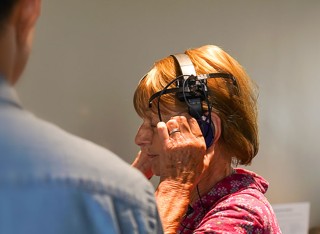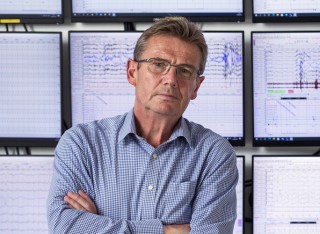
Dr Ines Violante
About
Biography
Dr. Violante has a multidisciplinary background, spanning from cellular to human studies. She earned her BSc in Biochemistry and PhD in Biomedical Sciences from the University of Coimbra. Following her PhD, she was awarded a Sir Henry Wellcome Fellowship, during which she conducted postdoctoral research at both Imperial College London and University College London.
She joined the University of Surrey in 2017 and was Senior Lecturer in Psychological Neuroscience until 2024. Dr Violante now holds a Senior Lecturer visiting position in the Faculty of Health and Medical Sciences at the University of Surrey and since 2024 is Senior Lecturer in Healthcare Engineering at the School of Biomedical Engineering & Imaging Sciences, King's College London.
Areas of specialism
ResearchResearch interests
My research focuses on understanding the role of brain networks on cognitive functions and the use of brain stimulation as a neuromodulator. My research combines functional magnetic resonance imaging (fMRI) and electroencephalography (EEG) to understand how brain stimulation (TMS, tACS, tDCS) can be used to modulate brain dynamics and behavioural performance. I am interested in how brain oscillations mediate long-range connectivity and particularly how neurostimulation can be used to improve network communication following neurological disorders.
A second strand of research that started during my PhD, has been focused on understanding the neurobiological basis of the cognitive deficits in neurodevelopmental disorders, particularly Neurofibromatosis type 1 (NF1). My research in this field is characterized by being interdisciplinary and translational, applying neuroimaging and neurophysiological techniques to translate the inhibitory hypothesis in NF1. I have used spectroscopy (MRS), molecular imaging (PET) and magnetic resonance imaging to provide a comprehensive understanding of the pathophysiological alterations present in NF1.
Research projects
Dynamic modulation of brain states using brain stimulation and neuroadaptive Bayesian optimizationIn order to support cognitive functions, the brain must coordinate the interactions among large-scale networks that cooperate and compete to allow for efficient transitions between brain states. Understanding how these operate, giving rise to different behaviours is one of the greatest challenges facing modern neuroscience.
The overarching aim of this project is to develop a framework capable of shaping the interactions between brain networks. In order to do this, we will combine transcranial alternating current stimulation (tACS) with a novel approach, neuroadaptive Bayesian optimization.
TACS is a promising tool to modulate brain function. The oscillatory electrical activity imposed by tACS has been shown to result in neural modulations that spread along brain networks. However, there are two main limitations to the application of tACS to modulate brain function: 1) the brain networks targeted by stimulation cannot be verified in the absence of brain imaging; 2) the stimulation parameters vary across individuals, due to a multitude of variables, such as age, sex and genetic factors. Thus, identifying the optimal stimulation protocol that drives a particular brain state in a given individual is like 'finding a needle in a haystack'. To address these fundamental challenges, we propose to use neuroadaptive Bayesian optimization, which uses a close-loop search combining real-time fMRI with machine learning. This approach conducts an automatic and intelligent search across the multitude of tACS parameters in order to identify those that optimally elicit a particular target state.
This framework has translational potential, as several psychiatric and neurological conditions are associated with impaired function of large-scale brain networks. The results of this project can lead to the development of therapeutic interventions that harness the potential of brain stimulation.
Research collaborations
Prof. Robert Leech, King's College London
Dr. Adam Hampshire, Imperial College London
Dr. Nir Grossman, Imperial College London
Prof. David Sharp, Imperial College London
Prof. John Rothwell, University College London
Dr. David Carmichael, King's College London
Dr. Miguel Castelo-Branco, University of Coimbra
Indicators of esteem
Research Grants
2019 - 2021: Dynamic modulation of brain states using brain stimulation and neuroadaptive Bayesian optimization. BBSRC (PI)
2018 - 2019: Developing a measure of conscious level with electroencephalography and transcranial electrical stimulation. Imperial Confidence in Concept (Co-PI)
2016 - 2017: Tailored non-invasive brain stimulation for rehabilitation of TBI using real-time time fMRI. NIHR Imperial Biomedical Research Centre (PI)
2014 - 2018: Stimulating brain network oscillations to improve attention after traumatic brain injury. Wellcome Trust (Sir Henry Wellcome Postdoctoral Fellow)
Honours, Awards and Fellowships
2013 Sir Henry Wellcome Postdoctoral Fellowship
2014 Finalist Young Investigator Award, World Molecular Imaging Conference, Seoul, South Korea
2013 Best Scientific Article - Clinical Research, Faculty of Medicine, University of Coimbra
2012 Certificate of Merit Award, ESMRMB 29th Annuak Scientific Meeting
2012 Trainee Abstract Travel Award, Organization for Human Brain Mapping
2011 Best Scientific Poster, 3rd Annual Meeting, IBILI, Portugal
2009 International Society for Magnetic Resonance in Medicine and Biology Travel Award
2008 International Society for Magnetic Resonance in Medicine and Biology Travel Award
2008 European Society for Magnetic Resonance in Medicine and Biology Travel Award
2008 PhD Fellowship, Portuguese Foundation for Science and Technology
2006 Erasmus Student Fellowship
Research interests
My research focuses on understanding the role of brain networks on cognitive functions and the use of brain stimulation as a neuromodulator. My research combines functional magnetic resonance imaging (fMRI) and electroencephalography (EEG) to understand how brain stimulation (TMS, tACS, tDCS) can be used to modulate brain dynamics and behavioural performance. I am interested in how brain oscillations mediate long-range connectivity and particularly how neurostimulation can be used to improve network communication following neurological disorders.
A second strand of research that started during my PhD, has been focused on understanding the neurobiological basis of the cognitive deficits in neurodevelopmental disorders, particularly Neurofibromatosis type 1 (NF1). My research in this field is characterized by being interdisciplinary and translational, applying neuroimaging and neurophysiological techniques to translate the inhibitory hypothesis in NF1. I have used spectroscopy (MRS), molecular imaging (PET) and magnetic resonance imaging to provide a comprehensive understanding of the pathophysiological alterations present in NF1.
Research projects
In order to support cognitive functions, the brain must coordinate the interactions among large-scale networks that cooperate and compete to allow for efficient transitions between brain states. Understanding how these operate, giving rise to different behaviours is one of the greatest challenges facing modern neuroscience.
The overarching aim of this project is to develop a framework capable of shaping the interactions between brain networks. In order to do this, we will combine transcranial alternating current stimulation (tACS) with a novel approach, neuroadaptive Bayesian optimization.
TACS is a promising tool to modulate brain function. The oscillatory electrical activity imposed by tACS has been shown to result in neural modulations that spread along brain networks. However, there are two main limitations to the application of tACS to modulate brain function: 1) the brain networks targeted by stimulation cannot be verified in the absence of brain imaging; 2) the stimulation parameters vary across individuals, due to a multitude of variables, such as age, sex and genetic factors. Thus, identifying the optimal stimulation protocol that drives a particular brain state in a given individual is like 'finding a needle in a haystack'. To address these fundamental challenges, we propose to use neuroadaptive Bayesian optimization, which uses a close-loop search combining real-time fMRI with machine learning. This approach conducts an automatic and intelligent search across the multitude of tACS parameters in order to identify those that optimally elicit a particular target state.
This framework has translational potential, as several psychiatric and neurological conditions are associated with impaired function of large-scale brain networks. The results of this project can lead to the development of therapeutic interventions that harness the potential of brain stimulation.
Research collaborations
Prof. Robert Leech, King's College London
Dr. Adam Hampshire, Imperial College London
Dr. Nir Grossman, Imperial College London
Prof. David Sharp, Imperial College London
Prof. John Rothwell, University College London
Dr. David Carmichael, King's College London
Dr. Miguel Castelo-Branco, University of Coimbra
Indicators of esteem
Research Grants
2019 - 2021: Dynamic modulation of brain states using brain stimulation and neuroadaptive Bayesian optimization. BBSRC (PI)
2018 - 2019: Developing a measure of conscious level with electroencephalography and transcranial electrical stimulation. Imperial Confidence in Concept (Co-PI)
2016 - 2017: Tailored non-invasive brain stimulation for rehabilitation of TBI using real-time time fMRI. NIHR Imperial Biomedical Research Centre (PI)
2014 - 2018: Stimulating brain network oscillations to improve attention after traumatic brain injury. Wellcome Trust (Sir Henry Wellcome Postdoctoral Fellow)
Honours, Awards and Fellowships
2013 Sir Henry Wellcome Postdoctoral Fellowship
2014 Finalist Young Investigator Award, World Molecular Imaging Conference, Seoul, South Korea
2013 Best Scientific Article - Clinical Research, Faculty of Medicine, University of Coimbra
2012 Certificate of Merit Award, ESMRMB 29th Annuak Scientific Meeting
2012 Trainee Abstract Travel Award, Organization for Human Brain Mapping
2011 Best Scientific Poster, 3rd Annual Meeting, IBILI, Portugal
2009 International Society for Magnetic Resonance in Medicine and Biology Travel Award
2008 International Society for Magnetic Resonance in Medicine and Biology Travel Award
2008 European Society for Magnetic Resonance in Medicine and Biology Travel Award
2008 PhD Fellowship, Portuguese Foundation for Science and Technology
2006 Erasmus Student Fellowship
Supervision
Postgraduate research supervision
Postgraduate research supervision
If you are a student who is interested in undertaking PhD or postdoctoral research in my lab then please feel free to email me directly at ines.violante_at_surrey.ac.uk.
Current Students
Danielle Kurtin (PhD Candidate)
Henry Hebron (PhD Candidate)
Will Mayes (PhD Candidate) - Multi-sensory integration in Developmental Coordination Dirorder
Paul Knytl (PhD Candidate) - Dopamine & Meditation
Publications
2024
Mayes W, Gentle J, Ivanova M, Violante IR. Audio-visual multisensory integration and haptic perception are altered in adults with developmental coordination disorder. Human Movement Science (2024) 93, 103180
2023
Violante IR, Alania K, Cassarà AM, Neufeld E, Acerbo E, Carron R, Williamson A, Kurtin DL, Rhodes E, Hampshire A, Kuster N, Boyden ES, Pascual-Leone A, Grossman N. Non-invasive temporal interference electrical stimulation of the human hippocampus. Nature Neuroscience (2023) 26, 1994–2004
Wessel MJ, Beanato E, Popa T, Windel F, Vassiliadis P, Menoud P, Beliaeva V, Violante IR, Abderrahmane H, Dzialecka P, Park C, Maceira-Elvira P, Morishita T, Cassara A, Steiner M, Grossman N, Neufeld E, Hummel FC. Noninvasive theta-burst stimulation of the human striatum enhances striatal activity and motor skill learning. Nature Neuroscience (2023) 26, 2005–2016
Auer T, Goldthorpe R, Peach R, Hebron H, Violante IR. Functionally annotated electrophysiological neuromarkers of healthy ageing and memory function. bioRxiv
Kurtin DL, Araña‐Oiarbide G, Lorenz R, Violante IR, Hampshire A. Planning ahead: Predictable switching recruits task‐active and resting‐state networks. Human Brain Mapping (2023)
Soleimani G, Nitsche MA, Bergmann TO, Towhidkhah F, Violante IR, Lorenz R, Kuplicki R, Tsuchiyagaito A, Mulyana B, Mayeli A, Ghobadi-Azbari P, Mosayebi-Samani M, Zilverstand A, Paulus MP, Bikson M, Ekhtiari H. Closing the loop between brain and electrical stimulation: towards precision neuromodulation treatments. Translational psychiatry (2023) 1, 279.
Kurtin DL, Giunchiglia V, Vohryzek J, Cabral J, Skeldon AC, Violante IR. Moving from phenomenological to predictive modelling: Progress and pitfalls of modelling brain stimulation in-silico. NeuroImage (2023) 272, 120042.
Kurtin DL, Scott G, Hebron H, Skeldon AC, Violante IR. Task-based differences in brain state dynamics and their relation to cognitive ability. NeuroImage (2023) 271, 119945.
2022
Brunoni AR, Ekhtiari H, Antal A, Auvichayapat P, et al. Digitalized transcranial electrical stimulation: A consensus statement. Clinical Neurophysiology (2022) 143, 154-165.
Giustiniani A, Vallesi A, Oliveri M, Tarantino V, Ambrosini E, Bortoletto M, Masina F, Busan P, Siebner HR, Fadiga L, Koch G, Leocani L, Lefaucheur JP, Rotenberg A, Zangen A, Violante IR, Moliadze V, Gamboa OL, Ugawa Y, Pascual-Leone A, Ziemann U, Miniussi C, Burgio F. A questionnaire to collect unintended effects of transcranial magnetic stimulation: A consensus based approach. Clinical Neurophysiology (2022), 141, 101-108.
Kurtin DL, Jaquiery M, Auer T, Hampshire A, Violante IR. Introducing the Task Switching Game: a paradigm for neuroimaging and online studies. F1000Research (2022), 11, 377.
Bernardino B, Dionísio A, Violante IR, Monteiro R, Castelo-Branco M. Motor cortex excitation/inhibition imbalance in young adults with Autism Spectrum Disorder: A MRS-TMS approach. Frontiers in Psychiatry (2022), 13, 860448.
Hebron H, Lugli B, Dimitrova R, Rhodes E, Grossman N, Dijk DJ, Violante IR. Perfect Timing: Effects of Auditory Stimulation on Alpha Oscillations During Wakefulness and the Transition to Sleep are Phase-dependent in Humans, BioRxiv.
Wessel MJ, Beanato E, Popa T, Windel F, Vassiliadis P, Menoud P, Beliaeva V, Violante IR, Abderrahmane H, Dzialecka P, Park C, Maceira-Elvira P, Morishita T, Cassara A, Steiner M, Grossman N, Neufeld E, Hummel FC. LTP-like noninvasive striatal brain stimulation enhances striatal activity and motor skill learning in humans. bioRxiv.
Violante IR, Alania K, Cassarà AM, Neufeld E, Acerbo E, Carron R, Williamson A, Kurtin DL, Rhodes E, Hampshire A, Kuster N, Boyden ES, Pascual-Leone A, Grossman N. Non-invasive temporal interference electrical stimulation of the human hippocampus. bioRxiv.
Ekhtiari, H., Ghobadi-Azbari, P., Thielscher, A. et al. A checklist for assessing the methodological quality of concurrent tES-fMRI studies (ContES checklist): a consensus study and statement. Nature Protocols (2022), 17, 596–617.
2021
Mayes W, Gentle J, Parisi I, Dixon L, van Velzen J, Violante IR. Top-down inhibitory motor control is preserved in adults with Developmental Coordination Disorder. Developmental Neuropsychology (2021), https://doi.org/10.1080/87565641.2021.1966431
Kurtin DL, Violante IR, Zimmerman K, Leech R, Hampshire A, Patel MC, Carmichael DW, Sharp DJ, Li LM. Investigating the interaction between white matter and brain state on tDCS-induced changes in brain network activity. Brain Stimulation (2021), 14:5, 1261-1270
Soreq E, Violante IR, Daws R, Hampshire A. Neuroimaging evidence for a network sampling theory of individual differences in human intelligence test performance. Nature Communications (2021), DOI: 10.1038/s41467-021-22199-9
Parkin B, Daws RE, Das Neves I, Violante IR, Soreq E, Martin-Bastida A, Sandrone S, Roussakis AA, Lao-Kaim NP, Piccini P, Hampshire A. Dissociable Effects of Age and Parkinson’s Disease on Instruction Based Learning. Brain Communications (2021)
Beppi C, Violante IR, Scott G, Sandrone S. EEG, MEG and neuromodulatory approaches to explore cognition: Current status and future directions. Brain and Cognition (2021) 148, 105677
2020
Ekhtiari H, et al. A Checklist for Assessing the Methodological Quality of Concurrent tES-fMRI Studies (ContES Checklist): A Consensus Study and Statement. medRxiv 2020.12.23.20248579; doi: https://doi.org/10.1101/2020.12.23.20248579
Goldthorpe RA, Rapley JM, Violante IR. A Systematic Review of Non-invasive Brain Stimulation Applications to Memory in Healthy Aging. Front. Neurol., (2020)
Cogdell-Brooke, L., Sowden, P., Violante, IR., and Thompson, HE. A meta-analysis of functional magnetic resonance imaging studies of divergent thinking using activation likelihood estimation. Human Brain Mapping (2020) 1:21
Cogdell-Brooke L, Stampacchia S, Jefferies E, Violante IR, Thompson HE. Consistently inconsistent: Multimodal episodic deficits in semantic aphasia. Neuropsychologia (2020)
Fagerholm ED, Tangwiriyasakul C, Friston KJ, Violante IR, Williams S, Carmichael DW, Perani S, Turkheimer FE, Moran RJ, Leech R, Richardson MP. Neural diffusivity and pre-emptive epileptic seizure intervention. PLOS Computational Biology (2020)
Fagerholm, ED, Moran, RJ, Violante, IR, Leech R, Friston KJ. Dynamic causal modelling of phase-amplitude interactions. NeuroImage (2020) 208: 116452
Arana-Oiarbide G, Daws RE, Lorenz R, Violante IR, Hampshire A. Preferential activation of the posterior Default-Mode Network with sequentially predictable task switches. bioRxiv
Beppi C, Violante IR, Hampshire A, Grossman N, Sandrone S. Patterns of Focal-and Large-Scale Synchronization in Cognitive Control and Inhibition: A Review. Frontiers in Human Neuroscience (2020) 14: 196
d’Almeida OC, Violante IR, Quendera B, Moreno C, Gomes L, Castelo-Branco M. The neurometabolic profiles of GABA and Glutamate as revealed by proton magnetic resonance spectroscopy in type 1 and type 2 diabetes. PLoS ONE (2020), 15(10): e0240907.
2019
Li LM, Violante IR, Zimmerman K, Leech R, Hampshire A, Patel M, Opitz A, McArthur D, Jolly A, Carmichael DW, Sharp DJ. Traumatic axonal injury influences the cognitive effect of non-invasive brain stimulation. Brain (2019) 142:3280-3293
Lorenz R, Simmons LE, Monti RP, Arthur JL, Limal S, Laakso I, Leech R, Violante IR. Efficiently searching through large tACS parameter spaces using closed-loop Bayesian optimization. Brain Stimulation (2019) 12:1484-1489
Hampshire A, Daws RE, Neves ID, Soreq E, Sandrone S, Violante IR. Probing cortical and sub-cortical contributions to instruction-based learning: Regional specialisation and global network dynamics. NeuroImage (2019) 192:88-100
Li LM, Violante IR, Leech R, Hampshire A, Opitz A, McArthur D, Carmichael DW, Sharp DJ. Cognitive enhancement with Salience Network electrical stimulation is influenced by network structural connectivity. NeuroImage (2019) 185:425-433
Li LM, Violante IR, Leech R, Ross E, Hampshire A, Opitz A, Rothwell JC, Carmichael DW, Sharp DJ. Brain state and polarity dependent modulation of brain networks by transcranial direct current stimulation. Hum Brain Mapp. (2019) 40(3):904-915
2018
Lorenz R, Violante IR, Monti RP, Montana G, Hampshire A, Leech R. Dissociating frontoparietal brain networks with neuroadaptive Bayesian optimization. Nature Communications (2018) 26;9(1):1227. doi: 10.1038/s41467-018-03657-3.
Silva G, Duarte IC, Bernardino I, Marques T, Violante IR, Castelo-Branco M. Oscillatory motor patterning is impaired in neurofibromatosis type 1: a behavioural, EEG and fMRI study. J Neurodev Disord. (2018) 22;10(1):11. doi: 10.1186/s11689-018-9230-4.
Carvalho Pereira A, Violante IR, Mouga S, Oliveira G, Castelo-Branco M. Medial Frontal Lobe Neurochemistry in Autism Spectrum Disorder is Marked by Reduced N-Acetylaspartate and Unchanged Gamma-Aminobutyric Acid and Glutamate + Glutamine Levels. J Autism Dev Disord. (2018) 48(5):1467-1482. doi: 10.1007/s10803-017-3406-8.
d’Almeida OC, Violante IR, Quendera B, Castelo-Branco M. Mitochondrial pathophysiology beyond the retinal ganglion cell: occipital GABA is decreased in autosomal dominant optic neuropathy. Graefe's Archive for Clinical and Experimental Ophthalmology (2018) 256(12),2341-2348.
2017
Violante IR, Li LM, Carmichael DW, Lorenz R, Leech R, Hampshire A, Rothwell JC, Sharp DJ. Externally induced frontoparietal synchronization modulates network dynamics and enhances working memory performance. eLife (2017), Mar 14;6. pii: e22001. doi: 10.7554/eLife.22001.
Sliwinska M, Violante IR, Wise R, Leech R, Devlin J, Geranmayeh F, Hampshire A. Stimulating domain-general neural networks improves vocabulary learning. Journal of Neuroscience (2017), 3857-16; DOI: https://doi.org/10.1523/JNEUROSCI.3857-16.2017
Gonçalves J, Violante IR, Sereno J, Leitão R, Cai Y, Abrunhosa A, Silva AP, Silva A, Castelo- Branco M. Testing the excitation/inhibition imbalance hypothesis in a mouse model of the autism spectrum disorder: in vivo neurospectroscopy and molecular evidence for regional phenotypes. Mol Autism. (2017) Sep 19;8:47. doi: 10.1186/s13229-017-0166-4. eCollection 2017.
Datta G, Violante IR, Scott G, Zimmerman K, Santos-Ribeiro A, Rabiner EA, Gunn RN, Malik O, Ciccarelli O, Nicholas R, Matthews PM. Translocator positron-emission tomography and magnetic resonance spectroscopic imaging of brain glial cell activation in multiple sclerosis. Multiple Sclerosis Journal (2017) 23(11):1469-1478.
2016
Violante IR, Ribeiro MJ, Patricio M, Bernardino I, Rebola J, Abrunhosa AJ, Ferreira N, Castelo-Branco M. GABA deficiency in NF1: a multimodal [11C]-Flumazenil and spectroscopy study. Neurology (2016) 87(9):897-904
Silva G, Ribeiro MJ, Costa GN, Violante IR, Ramos F, Saraiva J, Castelo-Branco M. Peripheral Attentional Targets under Covert Attention Lead to Paradoxically Enhanced Alpha Desynchronization in Neurofibromatosis Type 1. PLoS One (2016) 11(2):e0148600. doi: 10.1371/journal.pone.0148600.
Lorenz R, Monti RP, Violante IR, Anagnostopoulos C, Faisal AA, Montana G, Leech R. The Automatic Neuroscientist: A framework for optimizing experimental design with closed-loop real-time fMRI. Neuroimage (2016) 129:320-34.
2015
Ribeiro MJ, Violante IR, Bernardino I, Edden RAE, Castelo-Branco M. Abnormal relationship between GABA, neurophysiology and impulsive behavior in neurofibromatosis type 1. Cortex (2015) 64:194-208.
2013
Violante IR, Ribeiro MJ, Edden RAE, Guimarães P, Bernardino I, Rebola J, Cunha G, Silva E, Castelo-Branco M. GABA deficit in the visual cortex of patients with NF1: genotype-phenotype correlations and functional impact. Brain 136:3 (2013) 918-25.
Violante IR, Ribeiro MJ, Silva E, Castelo-Branco M. Gyrification, cortical and subcortical morphometry in Neurofibromatosis type 1: an uneven profile of developmental abnormalities. Journal of Neurodevelopmental Disorders 5:3 (2013) doi: 10.1186/1866-1955-5-3.
2012
Violante IR, Ribeiro MJ, Cunha G, Bernardino I, Duarte JV, Ramos F, Saraiva J, Silva E, Castelo-Branco M. Abnormal brain activation in neurofibromatosis type 1: a link between visual processing and the default mode network. PLoS One. 7:6 (2012) e38785.
Duarte JV, Ribeiro MJ, Violante IR, Cunha G, Silva E, Castelo-Branco M. Multivariate Pattern Analysis Reveals Subtle Brain Anomalies Relevant to the Cognitive Phenotype in Neurofibromatosis Type 1. Human Brain Mapping (2012) doi: 10.1002/hbm.22161
Ribeiro MJ, Violante IR, Bernardino I, Ramos F, Saraiva J, Reviriego P, Upadhyaya M, Silva ED, Castelo-Branco M. Abnormal achromatic and chromatic contrast sensitivity in neurofibromatosis type 1. Invest Ophthalmol Vis Sci. 53:1 (2012) 287-293.
2007 - 2011
Delgado TC, Violante IR, Nieto-Charques L, Cerdan S. Neuroglial metabolic compartmentation underlying leptin deficiency in the obese ob/ob mice as detected by magnetic resonance imaging and spectroscopy methods. J Cereb Blood Flow Metab. 31:12 (2011) 2257-2266.
Rodrigues TB, Violante IR, Cerdan S. Unambiguous assignment of the H3S and H3R deuterations of cerebral (2-13C) glutamate by 13C NMR at 18.8 Tesla. Magn Reson Med. 63:4 (2010) 1088-1091.
Violante IR, Anastasovska J, Sanchez-Canon GJ, Rodrigues TB, Righi V, Nieto-Charques L, Parkinson JR, Bloom SR, Bell JD, Cerdan S. Cerebral activation by fasting induces lactate accumulation in the hypothalamus. Magn Reson Med. 62:2 (2009) 279-283.
Ramirez BG, Rodrigues TB, Violante IR, Cruz F, Fonseca LL, Ballesteros P, Castro MM, Garcia-Martin ML, Cerdan S. Kinetic properties of the redox switch/redox coupling mechanism as determined in primary cultures of cortical neurons and astrocytes from rat brain. J Neurosci Res. 85:15 (2007) 3244-3253.
Conference Papers
Lorenz R, Monti RP, Hampshire A, Koush Y, Anagnostopoulos C, Faisal A, Sharp D, Montana G, Leech R, Violante IR. Towards tailoring non-invasive brain stimulation using real-time fMRI and Bayesian optimization. (2016) 6th International Workshop on Pattern Recognition in Neuroimaging (PRNI) - Best Paper Award
Lorenz R, Monti RP, Violante IR, Faisal A, Anagnostopoulos C, Leech R, Montana G. Stopping criteria for boosting automatic experimental design using real-time fMRI with Bayesian optimization. (2015) 5th NIPS Workshop on Machine Learning and Interpretation in Neuroimaging: Beyond the Scanner






